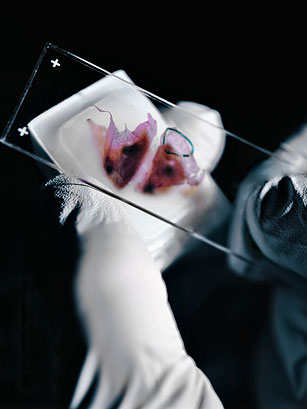
A scientist prepares to remove a small bit of tumor tissue — marked by the blue circle — from a biopsy sample for DNA sequencing
It seems jarring at first, all that violent imagery we use when we talk about cancer. It was 40 years ago, with the National Cancer Act of 1971, that President Nixon launched the War on Cancer, and since then, we fight with knife and laser and radiation and chemical weapons, we target tumors, we run reconnaissance with scans and tests, and we hunt down wayward cells that sneak away from the original lesion to seed new growths elsewhere.
Until now, all the aggressive posturing was intentional and, some would argue, necessary in order to engage a disease as insidious as this. Once a healthy cell picks up signals to grow, grow, grow, it indeed becomes a biological enemy, one that left unchecked can infiltrate, overtake and ultimately shut down normal tissues and organs.
Yet while we have focused so obsessively on cutting out tumors or poisoning them with toxic drugs, we have forgotten that there is another strategy, one that takes a more sophisticated approach than carpet bombing the enemy and instead requires studying it up close, learning its ways and weaknesses and then letting that knowledge work for you.
This is the strategy luring more and more researchers into the next phase of cancer care, one in which the science of genes is applied to the biology of cancer, allowing us to peer deep into the clockwork of a cancer cell and then jam its gears or pull out its mainspring. It means that treating cancer may be not an all-or-nothing endeavor but rather a long-term crusade between tumor and therapy, similar to the way we handle chronic diseases like HIV and other infections — with combinations of drugs in a constantly evolving fashion. Such an approach could be far more precise than the scalpels-and-toxins strategy, but it requires us to do one very big thing: learn to read cancer's DNA.
Cancer genomics represents a relatively simple but powerful idea: that the tumor until now has been a forgotten player — dismissed, in part because it was destined to be eliminated anyway, but more out of ignorance, because scientists simply couldn't suss out its secrets. Turning cancer's DNA against it requires you to understand the malignant cell's likes and dislikes, the biological and molecular enablers that keep it alive at the expense of healthy cells around it. What's more, targeting tumors isn't as easy as drawing a clear line between friend and foe. By its very nature, cancer is a perverted version of what's normal, a case of our cells going rogue. A malignancy is indeed a biological adversary, but it didn't start out that way. In the beginning, every cancer is nothing more than a group of healthy cells that for a variety of reasons — an inherited genetic anomaly, tobacco exposure, too many ultraviolet rays from the sun — turns against us. Finding out why this happens calls for more knowledge about genetic science than we have had in decades past. And just as important, you have to appreciate that all of those factors can be different for every different kind of cancer — or even every different patient. Only then can you hope to conquer the disease from the inside out.
"We like to call it a disruptive technology," says Dr. Matthew Ellis, professor of medicine at Washington University in St. Louis and a leader in sequencing the DNA of cancer cells. "Once we translate this technology into the clinical setting, it will completely rewrite the textbook on cancer, because we can start to fundamentally understand each patient's cancer genome and design treatments to match that genomic information."